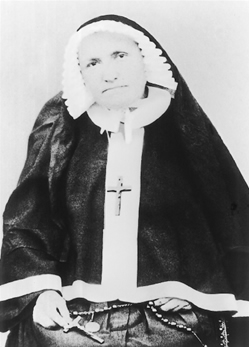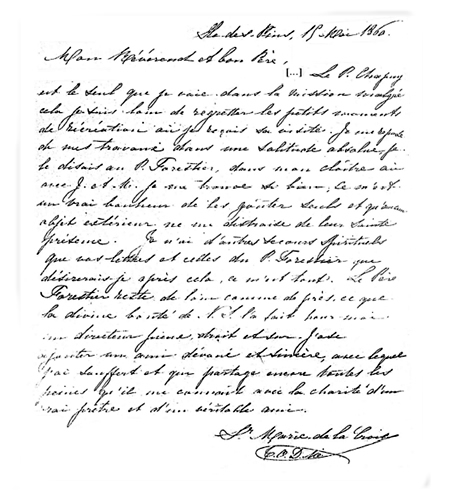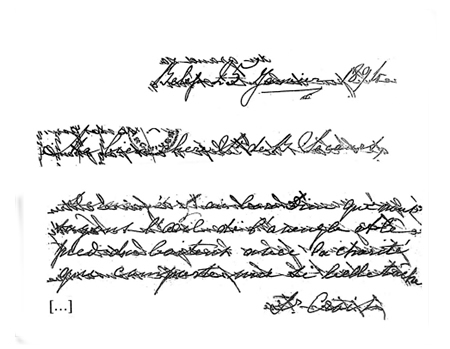04/09/2025
Needs of the Church, the Congregation and the world
04/09/2025
Needs of the Church, the Congregation and the world
04/09/2025
Prayer Intentions of the Pope
04/09/2025
Prayer Intentions of the Pope
06/08/2025
Deceased Sister: Sr. Gail Mary Colquhoun
23/07/2025
Deceased Sister: Sr. Malia Elisapeta Tapusoa (Matalena Tapusoa)
23/07/2025
Deceased Sister: Sr. Ana Marzolo (Linda Ann Marzolo)






Our pioneers | The Vocation of the Pioneers
Sister Marie de la Croix - Missionary in New Caledonia
 It was at La Roche-sur-Yon that Pélagie Phelippon was born in 1831. She received a good education in a convent school in Bordeaux and afterwards taught very successfully at a school there herself. In 1857, she made known to Fr Favre in Lyon her desire to give herself to the missions of Oceania. She was then 26 years of age. She had desired to be a religious from a very early age. Having been accepted for Oceania despite her questionable health, she arrived with two companions, Srs Marie de Bon Secours and Marie de la Paix at La Conception (New Caledonia) in December 1858. She set to work straight away to teach the women and children, to care for the sick and to learn the language.
It was at La Roche-sur-Yon that Pélagie Phelippon was born in 1831. She received a good education in a convent school in Bordeaux and afterwards taught very successfully at a school there herself. In 1857, she made known to Fr Favre in Lyon her desire to give herself to the missions of Oceania. She was then 26 years of age. She had desired to be a religious from a very early age. Having been accepted for Oceania despite her questionable health, she arrived with two companions, Srs Marie de Bon Secours and Marie de la Paix at La Conception (New Caledonia) in December 1858. She set to work straight away to teach the women and children, to care for the sick and to learn the language.
Five months later Fr Rougeyron decided she and Marie de Bon Secours would open a school on the Ile des Pins. In October 1863 she ran into difficulties with the laws passed against Catholic schools by the governor, Charles Guillain. She succeeded in passing the examination she had to take. Finally, her school could reopen in 1865.
Marie de la Croix was a woman of strong likes and dislikes: in some of the priests she could see no fault; in others little to commend them. As the years went on she came to a more balanced appreciation of others, to a greater compassion. She was surely helped by Fr Poupinel and perhaps others in whom she could confide.
In August 1864, she was sent to St Louis (New Caledonia) where she spent 28 years. There she began a day school, opened a boarding school and set up a novitiate for local sisters in whom she placed great confidence and hope for the future. Some made profession in the TORM but after several years, those coming on were encouraged to remain Petites Filles de Marie (Little Daughters of Mary) and become a diocesan congregation.
In 1892 she left St Louis, having volunteered to look after the leprosy patients in Bélep, an island to the north of New Caledonia, where they were completely neglected after being exiled there. Her letters, and those of others, testify to her love and care of these suffering people. She wrote: “I am only the servant of the poor leprosy patients. May God be blessed in all this” (Croix-Ste Anne, 04.09.1895, Letter 414, §1*). In writing to Marie de Bon Secours, she says: “Ask the good Lord that we may be the eyes of the blind and the feet of the lame, with the charity fitting such a beautiful task” (Croix-Bon Secours, 25.01.1894, Letter 354, §5*). Her companion, Sr Marie St Jean l’Evangeliste, whom she had formed for religious life, and who was professed in the TORM in 1892, affirms: “Our mother will finish her last years as she spent her early ones, doing good to everyone” (M. St Jean-Apollonie pfm, 28.12.1895*).
Both Srs Marie de la Croix and Marie St Jean were very distressed when, in 1898, the government decided to close the leprosarium in Bélep and send away the patients: “These poor people were crying, they extended their hands which we grasped without dreaming of any danger at all! We held these stumps of hand, without fingers. Oh, these unfortunate people whom we loved so greatly, and that we were so happy to console” (Croix-Eugénie, pfm, 06.05.1898, Letter 463, §2*). When the original people of Bélep returned to their island, the two sisters remained helping them resettle and opened the school again.
Marie de la Croix continued her work, despite her physical limitations, until her death on 9th August 1908, after having celebrated the preceding May, 50 years of missionary life, judged by others as outstanding in so many ways.
Marie de la Croix was profoundly Marist: in her letters and writings she speaks often of her attachment to the Society of Mary, Mary’s family, and its Third Order; she looks on Fr Colin as ‘Father founder;’ she speaks of trying to live the spirit of Mary and encourages the Petites Filles de Marie, the local congregation for whose religious formation she was responsible for many years, to love Mary, their mother and first superior, “our all after Jesus,” (Croix-Yardin, 02.09.1861, Letter 34,§6*) and to live her spirit.
The letters of Marie de la Croix make it obvious that she was a woman of prayer. There is constant reference to prayer and union with God in her letters. The Eucharist held an important place in her life. In her personal prayer, she knew the experience of desert dryness and shares this in writing with Marie Ste Anne: “Ah, if you could let the graces you received during your retreat flow into my poor soul, on to me freezing in the full light of the sun” (Croix-Ste Anne, 27.03.1901, Letter 500, §1*). She encourages the sisters to pray for one another and, in writing to her former novices, stresses the importance of prayer: “Let us unite in incessant prayer that the Lord may be loved everywhere and by all” (Croix-Colette, pfm, 26.11.1896, Letter 444, §6*). Many letters show that her prayer embraced the world - bishops, priests, sisters TORM and PFM, the children of St Louis, the leprosy patients, France, the Church, local and universal (cf. Croix-Ste Anne, 06.05. 1903, Letter 528, §12*).
She leaves us all, smsm and Filles de Marie, a heritage of about 600 letters but, more important, the very powerful continuing witness of a life completely given to God, lived in the spirit of Mary, whom she loved and revered as mother, model, first and perpetual superior.

… Fr Chapuy is the only one I see in the mission; despite that I have not the least regret for the little times of recreation which his visits give me. I rest from my labours in an absolute solitude. I was saying to Fr Forestier, in a cloister where, with Jesus and Mary I find myself so much at home; for me this is real happiness to ‘taste’ them only and where nothing from outside can distract me from their holy presence. I have no other spiritual help than your letters and those of Fr Forestier. What would I desire after that? It is all that I need. Whether from a distance or near, Fr Forestier remains what Our Lord in his divine goodness has made him for me: a holy spiritual director, honest and sure. I dare to add a sincere and devoted friend with whom I have suffered and who continues to share all the pain that he knows I have with the charity of a true priest and a real friend (Croix-Poupinel, 15.05.1860*).

Ask the good Lord that we may be the eyes of the blind and the feet of the lame, with the charity fitting such a beautiful task. […] (Croix-Bon Secours, 25.01.1894*).
2712 visits